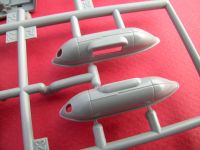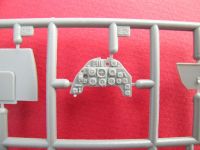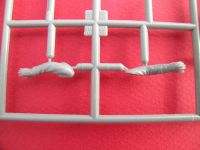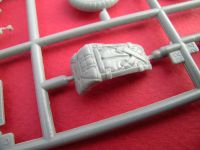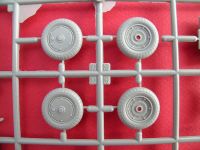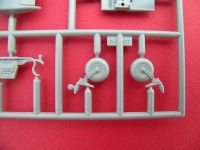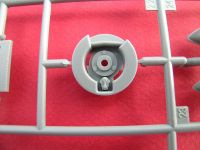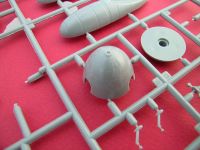Hasegawa | ST17/08067: Messerschmitt Bf 109G-6
Reviewed by Kevin Williams

I'll start out here by saying that in my opinion, this is the definitive Bf 109G-6 available in this scale. While the Revell kit, by comparison, has some nice features (late style tail and Erla canopy, for instance), the Revell kit also comes up short in a few areas. It might be possible to use some of the late features of the Revell kit to doctor up this kit, however I've done no fittings to determine how easy or difficult this might prove to be. If one seriously wanted to do a late G-6 here, it might be possible to rob some parts from one of the Hasegawa boxings of the Bf 109G-14, but again, I haven't confirmed that.
Hasegawa continues with the rather unpleasant habit of dumping all sprues (save for the clear parts), into one bag, leading, in this case, to scratched/abraded and broken loose pieces. Where pieces have broken loose, I've taken individual photos of them. I think it's also worth mentioning that some photos are indeed duplicated here, as they better help to illustrate separate areas of the air-frame.
(Since this is more of an in-box review than a build review, I have no photos of assembled sub structures, so my inputs should be considered more of an overview of the various areas I thought might be of interest, rather than an analysis of any accuracy issues, if indeed any are inherent.)
Note: No photo-etch is provided in this kit, so for things like lap belts and whatnot, those will need to be sourced elsewhere.
Instructions
Instructions are depicted in the typical Hasegawa pictographic way, making assembly a fairly straightforward process. Much to my happiness, a complete parts chart is provided within the provided instruction booklet. The usual disclaimers/warnings are also included; don't stick sharp objects in your eye, don't sniff the glue, don't feed the parts to your child, etc.
Decals
Markings are provided here for two G-6 air-frames, those being:
- Bf 109G-6, Yellow "1", 9/JG52, Erich Hartmann, "The Ace of Aces" (352 confirmed victories), also referred to by the the Russians as "The Black Devil"
- Bf 109G-6, White "5" (in black chevrons), II/JG52, Gerhard Barkhorn, (301 confirmed victories, and the second highest scoring ace of all time)
Decals appear to be in register, quite opaque, and well detailed, with plenty of stenciling, but not thin, not by a long shot. I'm assuming most folks will choose AM decals anyway, so this is probably no real big deal. Personally, I will undoubtedly chased down AM decals for mine anyway, so this is certainly not a deal breaker for me. No mention is made of where these decals were printed, but aside from the aforementioned "thick and chunky" issue, may work out well for some, and will probably prove more than adequate for those wishing to build either one of the out-of-box version(s) offered.
Major Kit Sprues
Offered up here, are a selection of major sprue components, with more detailed photos in the categories to follow. (Clearly visible, is the scratching/abrading, resultant from all of the sprues being dumped into one bag, a practice that I certainly don't understand or approve of.) While the surface damage that's been done using this method is certainly not insurmountable (a few swipes with some Scotch-Brite pads will certainly smooth things out just fine), it mars the otherwise gorgeous moldings.
Fuselage Major Components
Most major fuselage components are represented above. Proportions and detailing are done to a very high level indeed. One note: it would seem that Hasegawa used a slightly deeper tooling for panel lines and rivet/fastener detailing here, and I highly approve of this approach. Even after several coats of paint, one should still be able to easily get a wash to snuggle down into these recessed areas. Without a direct comparison to other Hasegawa tooling, this may just be my imagination run amok, but I don't believe so. Either way, the tooling is some of the best yet that I've seen from this company, and that's saying quite a lot.
Rear fuselage/tail breakdown, is clear evidence of an attempt to get more mileage from the tooling, offering up other variants (G-14, etc.), as possibilities, which of course, Hasegawa has indeed done.
Wings & Wing Armament
Again, wings are very well detailed, and to a high standard. The included under-wing 20mm (R6) gun packs, really look good to me (neither included scheme, is depicted as having carried them). Barrels for the 20mm, while acceptable, are not hollowed out on the muzzle end, so might be better off being replaced with small diameter tubing of some sort. As is fairly typical, wheel well openings are really not all that accurate, but there are a few aftermarket options available, for those that care about such things (I do not).
Flying Surfaces, General
Flying surfaces are again, done to a high degree of quality, with the rudder looking especially good to me. The ribbing on the fabric areas may be a wee bit overdone, but a few swipes with a Scotch-Brite pad, will swiftly take care of that.
The Cockpit
All in, the 'pit would appear to build up into quite an acceptable representation of the real McCoy, based upon the somewhat confusing and conflicting data that I've seen thus far. (It seems that the G-6, in particular, was in an almost constant state of evolution, as particulars seem to vary all over the map.) No P.E. belts are included, so those will need to be sourced elsewhere.
Pilot Figure
The kit includes one seated pilot figure, that, all things considered, looks pretty decent, the weak point, in my opinion, being the very soft details of the face, looking much more "doll like" than the real deal, but otherwise, a very acceptable figure.
Canopy & Clear Parts
The clear parts are exactly that, crystal clear. Clarity is astounding, as the photos readily attest. Also note: two different styles of windscreen are provided, one with a flare port (I assume), one with a cooling scoop of some sort, both being located on the starboard side.
Fuel Tank
One centerline fuel tank and mounting pylon is provided, and looks quite acceptable to my eye.
Landing Gear, Wheels & Tires
Landing gear is actually reasonably well detailed, with the main wheels themselves looking exceptionally good. The MLG doors (interior), have some pin marks that will need to be dealt with, but are actually not all that bad at all. The one piece tail wheel assembly (wheel/tire molded integrally with the tail wheel fork), is a bit of a pain, but does not pose an insurmountable problem either, and once painted, should look just fine.
Prop/Spinner
Nothing really special here at all, save to say that proportions (diameter, chord, twist, etc.) look good, as does spinner, at least to me, and is therefore good enough to use, "as is". It may be that the prop blades themselves, are a bit "undernourished", but I have no way to verify that.
Miscellany
As is somewhat typical for me, I ended up with a few photos for which I have no convenient category, so I've dumped them all here, as they are undoubtedly relevant.
Summation
All in all, I think this is a very commendable effort from Hasegawa, and I am very pleased with what I've found so far. I anxiously await the opportunity to begin working on my example. I also expect that the AM folks will jump on when and where needed (and in fact already have to some degree, with 'pit sets, guns, photo-etched sets, wheels/tires, exhausts, etc., not to mention the myriad decals/schemes), to provide us with additional enhancements for this cool kit. I'd also like to make the point that the contents within, constitute the great kit quality that one might tend to expect from Hasegawa, a handsome kit indeed, and is quite desirable as a consequence, as well as unquestionably being the best '109G-6 on the market, at least in this particular scale, and in my personal view.
This kit is highly recommended by this reviewer, for overall aesthetic appeal, and for giving us another choice by which to display the brute force, and yet elegant appearance of this truly iconic aircraft.
Acknowledgment
Many thanks to HobbyLink Japan for the review kit, which can be purchased at the following link:
1/32 Hasegawa Messerschmitt Bf 109G-6© Kevin Williams 2017
This product is available from the following LSP sponsors
This review was published on Thursday, October 26 2017; Last modified on Tuesday, May 18 2021

































